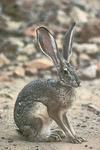- hare
-
—harelike, adj.n.1. any rodentlike mammal of the genus Lepus, of the family Leporidae, having long ears, a divided upper lip, and long hind limbs adapted for leaping.2. any of the larger species of this genus, as distinguished from certain of the smaller ones known as rabbits.3. any of various similar animals of the same family.5. the player pursued in the game of hare and hounds.v.i.6. Chiefly Brit. to run fast.
* * *
IBounding mammal (in the family Leporidae) whose young, unlike those of rabbits, are born fully haired, with open eyes, and sufficiently advanced to hop about a few minutes after birth.The common hare (Lepus europaeus) is native to central and southern Europe, the Middle East, and Africa; introduced into Australia, it has become a pest there. In North America the jackrabbit and snowshoe hare are widespread. Many other species occur naturally on all principal landmasses except Australia. Hares have well-developed hind legs, and the ears are usually longer than the head. Species vary in length from 16 to 28 in. (40–70 cm), without the short tail. Hares in northern latitudes are white in winter and grayish brown in summer; elsewhere, they are usually grayish brown year-round. Hares are primarily herbivorous. Black-tailed jackrabbit (Lepus californicus)II(as used in expressions)Haring Keith
Black-tailed jackrabbit (Lepus californicus)II(as used in expressions)Haring Keith* * *
▪ peoplealso called Kawchottinegroup of Athabaskan-speaking North American Indians originally living northwest of what is now Great Bear Lake in far northwestern Canada. Their name for themselves, Kawchottine, means “People of Great Hares”; it was used because Arctic hares were an important source of food in traditional culture, supplementing the group's main diet of fish. The hare was also the tribe's main source of skins for clothing, although caribou fur was preferred when available. The Hare were noted for a certain shyness and reclusiveness from neighbouring Eskimo (Inuit) and other tribes. The Hare were scattered in many independent bands; culturally, they resembled the Slave tribe and other American Subarctic peoples.Early 21st-century population estimates indicated some 1,000 Hare descendants.* * *
Universalium. 2010.
